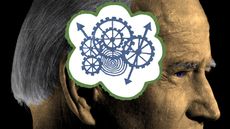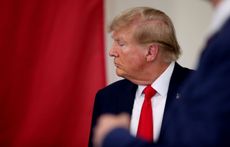Why Modern Monetary Theory is an unserious idea for an unserious time
The Democrats' new economic idea is too good be true


Big ideas? Well, Democrats have plenty of those. Expensive ones, too. A "New Green Deal." Medicare for everyone. A federal job guarantee. Free college tuition.
But a way to pay for all those trillions in big ideas? That, unfortunately, Democrats do not have. Raising the top tax rate for the super-rich wouldn't raise nearly enough dough to prevent all those policy plans from ballooning the already historically high national debt. And Democrats seem to have little stomach for raising taxes on anyone else. Blue state pols have been scrambling to figure out ways to prevent upper-middle-class households from paying more taxes as a result of the Trump tax cuts capping the federal deduction for state and local taxes. House Speaker Nancy Pelosi even tried instituting a rule that would require a supermajority to raise individual income taxes on the lowest-earning 80 percent of taxpayers. So talk of America someday having broad-based, value-added tax — which the big welfare states of Europe all have — looks like a fantasy. And without something like that, the financial math for the Democratic wish list doesn't really work — economically or politically.
So time for some new math. Democrats, especially the progressive left, think they have discovered a sort-of fiscal cheat code that would allow them to implement all those big ideas without worrying about taxes and deficits and debt. It's called Modern Monetary Theory. And despite the near-wondrous properties ascribed to MMT by its most fervent devotees, it's derived from the decidedly muggle-esque observation that a government whose debt is in the currency it creates will never be unable to pay its bills unless it so chooses. As my AEI colleague Stan Veuger explains in a recent MMT research note, "No matter how great outstanding government debt is, the government can always create more currency through a keystroke instead of being forced into involuntary default."
Subscribe to The Week
Escape your echo chamber. Get the facts behind the news, plus analysis from multiple perspectives.

Sign up for The Week's Free Newsletters
From our morning news briefing to a weekly Good News Newsletter, get the best of The Week delivered directly to your inbox.
From our morning news briefing to a weekly Good News Newsletter, get the best of The Week delivered directly to your inbox.
In short, Uncle Sam owns and runs the printing presses through the Federal Reserve. So MMTers argue that Washington should take advantage of this economic reality to finance all their spending fantasies by printing rather than taxing. And if all that money creation should one day prove inflationary — too much money chasing after too few goods — then Congress can raise taxes to drain excess cash from the system. In other words MMT flips the macroeconomic script: The Fed would finance spending programs, while lawmakers would make sure inflation stays quiescent.
Of course, this is kind of how things already work in practice. Government borrows and spends today under the assumption that it has plenty of ability and willingness to raise taxes tomorrow to pay for it. Benefits today, costs tomorrow. What MMT would do is somehow institutionalize that arrangement and turbocharge it. But more importantly in the current political environment, MMT creates a scholarly-sounding permission structure for politicians to spend lots more money and run up lots more debt without concern for pesky "pay-fors" until some time in the distant future — hopefully many, many election cycles away.
MMTers might dislike like the comparison, but their model is the lefty version of the Laffer Curve, the beloved economic construct of GOP tax-cutting "supply-siders." Like MMTers, the most ardent supply-siders take a simple economic observation — about tax rates and tax revenue — to make a big conceptual leap — that tax cuts pay for themselves. Also like Lafferistas, MMT don't much sweat deficits and debts. (In a bit of cheeky cosmic coincidence, it was Arthur Laffer himself who played matchmaker among some early MMT theorists.) And although that may not be how leading MMT-loving academics, such as former Bernie Sanders economic advisor Stephanie Kelton, see things — they stress MMT does have financial limits — the nuances may get lost on politicians and #Resistance folks.
No clever new economic theory, however, has made untrue this maxim: to govern is to choose. And MMT places far too much confidence in lawmakers making tough choices such as keeping inflation in check through taxation. Indeed, one reason advanced economies have independent central banks is because political influence on monetary policy has so often proved ruinous. So here's the risk from MMT: If a) inflation isn't quite so moribund as MMTers are betting, and b) politicians today are no more adept than their predecessors in resisting the temptation to pay for spending through encouraging massive money printing, then, as Veuger writes, "hyperinflation becomes a real risk."
Of course one can hardly blame Democrats — well, not too much — for latching onto such theories as MMT when Republicans are so deeply immersed in their own magical fiscal thinking. The Washington consensus on the dangers of debt has flipped just as completely as MMTers wish to do with macroeconomic policy. Unseriousness apparently breeds more unseriousness.
Create an account with the same email registered to your subscription to unlock access.
Sign up for Today's Best Articles in your inbox
A free daily email with the biggest news stories of the day – and the best features from TheWeek.com
James Pethokoukis is the DeWitt Wallace Fellow at the American Enterprise Institute where he runs the AEIdeas blog. He has also written for The New York Times, National Review, Commentary, The Weekly Standard, and other places.
-
 'Make legal immigration a more plausible option'
'Make legal immigration a more plausible option'Instant Opinion Opinion, comment and editorials of the day
By Harold Maass, The Week US Published
-
 LA-to-Las Vegas high-speed rail line breaks ground
LA-to-Las Vegas high-speed rail line breaks groundSpeed Read The railway will be ready as soon as 2028
By Peter Weber, The Week US Published
-
 Israel's military intelligence chief resigns
Israel's military intelligence chief resignsSpeed Read Maj. Gen. Aharon Haliva is the first leader to quit for failing to prevent the Hamas attack in October
By Justin Klawans, The Week US Published
-
 Arizona court reinstates 1864 abortion ban
Arizona court reinstates 1864 abortion banSpeed Read The law makes all abortions illegal in the state except to save the mother's life
By Rafi Schwartz, The Week US Published
-
 Trump, billions richer, is selling Bibles
Trump, billions richer, is selling BiblesSpeed Read The former president is hawking a $60 "God Bless the USA Bible"
By Peter Weber, The Week US Published
-
 The debate about Biden's age and mental fitness
The debate about Biden's age and mental fitnessIn Depth Some critics argue Biden is too old to run again. Does the argument have merit?
By Grayson Quay Published
-
 How would a second Trump presidency affect Britain?
How would a second Trump presidency affect Britain?Today's Big Question Re-election of Republican frontrunner could threaten UK security, warns former head of secret service
By Harriet Marsden, The Week UK Published
-
 'Rwanda plan is less a deterrent and more a bluff'
'Rwanda plan is less a deterrent and more a bluff'Instant Opinion Opinion, comment and editorials of the day
By The Week UK Published
-
 Henry Kissinger dies aged 100: a complicated legacy?
Henry Kissinger dies aged 100: a complicated legacy?Talking Point Top US diplomat and Nobel Peace Prize winner remembered as both foreign policy genius and war criminal
By Harriet Marsden, The Week UK Last updated
-
 Trump’s rhetoric: a shift to 'straight-up Nazi talk'
Trump’s rhetoric: a shift to 'straight-up Nazi talk'Why everyone's talking about Would-be president's sinister language is backed by an incendiary policy agenda, say commentators
By The Week UK Published
-
 More covfefe: is the world ready for a second Donald Trump presidency?
More covfefe: is the world ready for a second Donald Trump presidency?Today's Big Question Republican's re-election would be a 'nightmare' scenario for Europe, Ukraine and the West
By Sorcha Bradley, The Week UK Published